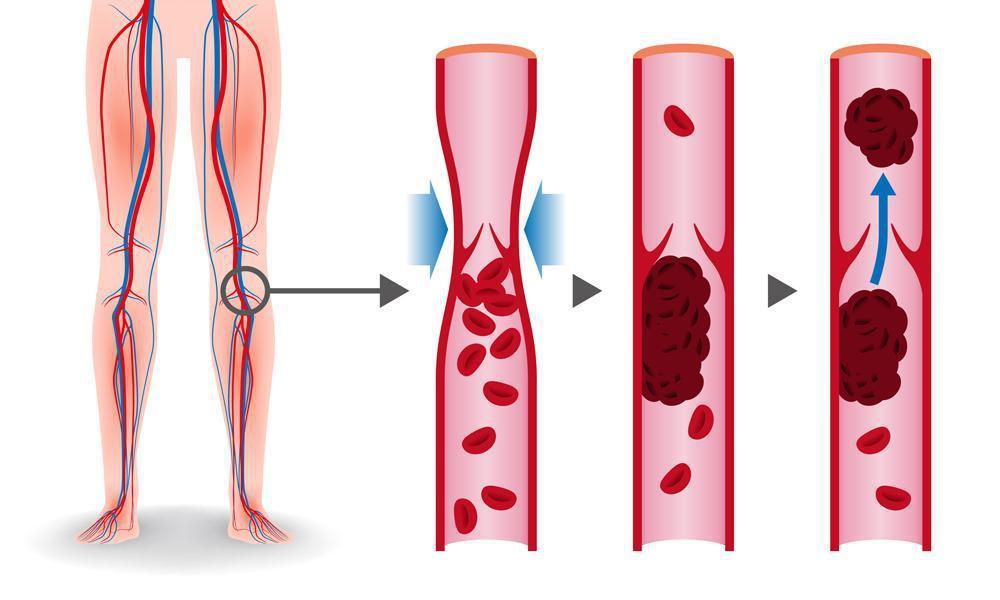When your leg feels sore, swollen, or unusually heavy, you might think it’s just fatigue or a muscle pull. But sometimes, these signs can point to something far more serious — a blood clot in leg, also known as deep vein thrombosis (DVT).
DVT happens when blood thickens and forms a solid mass inside a deep vein, usually in the calf or thigh. It’s not just a local problem — if a clot breaks free and travels to your lungs, it can cause a pulmonary embolism (PE), which can be life-threatening.
In this guide, we’ll break down Blood Clot in Leg Symptoms: How to Spot DVT Early, so you can recognize the warning signs, understand the causes, and know when to seek medical help.
What is Deep Vein Thrombosis (DVT)?
Deep vein thrombosis is a condition where a clot forms deep inside the body’s veins. The veins in your legs carry blood back to the heart. When the blood flow slows or becomes sluggish, it increases the chance of a clot forming.
DVT can occur in anyone, but certain risk factors make it more likely. Spotting it early is key to avoiding complications.
Causes of Blood Clots in the Leg
Several factors can contribute to the formation of a clot:
- Prolonged immobility – Long flights, car rides, or bed rest after surgery can slow blood flow.
- Injury to the vein – Trauma, fractures, or surgery can damage vein walls.
- Medical conditions – Cancer, heart disease, or clotting disorders increase risk.
- Hormonal changes – Birth control pills, hormone therapy, or pregnancy can make blood more likely to clot.
- Lifestyle factors – Smoking, obesity, and dehydration all play a role.
Early Warning Signs of a Blood Clot in the Leg
Recognizing Blood Clot in Leg Symptoms: How to Spot DVT Early is crucial because the sooner you act, the better the outcome.
Here are the main symptoms to watch for:
1. Swelling in One Leg
Swelling that appears suddenly and affects only one leg is a common DVT sign. The swelling happens because the clot is blocking blood flow, causing fluid buildup.
2. Unexplained Leg Pain
Unlike muscle soreness, DVT pain often has no obvious cause like exercise or injury. It may feel like a cramp, ache, or tightness that worsens when you walk or stand.
3. Warmth Over the Affected Area
If part of your leg feels noticeably warmer than the surrounding skin, it may be due to inflammation caused by a clot.
4. Skin Discoloration
A clot can cause the skin to turn red, blue, or purple. This is due to poor blood circulation in the affected area.
5. Tenderness Along a Vein
You might notice pain when pressing on a vein in your leg, especially in the calf or thigh.
How to Tell DVT Apart from Other Leg Problems
Leg pain can result from many issues — muscle strain, arthritis, varicose veins — but there are some key differences:
| Feature | Muscle Pain | Blood Clot in Leg (DVT) |
|---|---|---|
| Cause | Overuse, injury | Blood flow blockage in deep vein |
| Swelling | Minimal | Significant, one-sided |
| Skin color | Normal | Red, blue, or purple |
| Warmth | Rare | Common over clot area |
| Relief with rest | Yes | No |
When DVT Becomes an Emergency
A blood clot is dangerous because it can travel to your lungs, causing a pulmonary embolism. Seek emergency care if you notice:
- Sudden shortness of breath
- Chest pain that worsens when breathing deeply
- Rapid pulse
- Coughing up blood
These are signs that a clot may have moved from your leg to your lungs.
Diagnosis of a Blood Clot in the Leg
If you suspect DVT, a doctor will likely:
- Perform a physical exam to check swelling, tenderness, and color changes
- Order an ultrasound to visualize blood flow in your veins
- Conduct a D-dimer blood test to detect clotting activity
- In rare cases, use a venogram (X-ray with dye) for detailed imaging
Treatment for DVT
Once diagnosed, treatment aims to stop the clot from growing and prevent new clots from forming.
1. Blood Thinners (Anticoagulants)
Medications like warfarin, heparin, or newer oral anticoagulants reduce clotting risk.
2. Thrombolytic Therapy
In severe cases, clot-busting drugs may be used to dissolve the clot quickly.
3. Compression Stockings
These improve blood flow and reduce swelling.
4. Surgery or Filters
In rare situations, doctors may place a filter in the vena cava (large vein) to prevent clots from reaching the lungs.
Preventing Blood Clots in the Leg
Prevention is especially important if you have risk factors. Here’s what you can do:
- Move regularly – Take breaks to walk and stretch during long trips or desk work.
- Stay hydrated – Proper hydration keeps blood flowing smoothly.
- Exercise – Keep your legs strong and active.
- Avoid smoking – Smoking damages blood vessels and increases clot risk.
- Follow doctor’s advice after surgery – Take prescribed medications and avoid prolonged bed rest.
Living with a History of DVT
If you’ve had DVT before, your doctor may recommend long-term precautions, such as:
- Wearing compression stockings daily
- Regular check-ups to monitor blood flow
- Continuing medication to reduce recurrence risk
Conclusion
Spotting Blood Clot in Leg Symptoms: How to Spot DVT Early can save your life. The key is to take any unusual swelling, pain, warmth, or skin changes seriously — especially if they happen in one leg.
DVT is treatable when caught early, but delaying care can lead to life-threatening complications like pulmonary embolism. If you suspect a clot, seek medical attention immediately.


